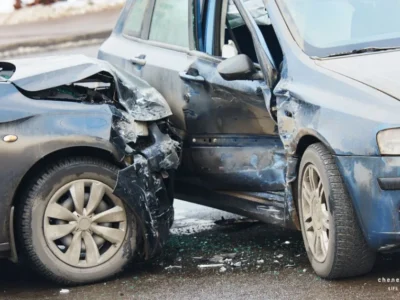Car accidents can happen unexpectedly and with devastating results. One of the most dangerous types of car accidents is a side-impact accident, in which one vehicle strikes another on the side. Commonly called “T-bone” accidents, it is possible for any side-impact accident to result in severe or fatal injuries. A Denver Car Accident side-impact accident lawyer is an ideal resource for anyone who has experienced such an incident.
Side-impact collisions are some of the most dangerous types of car accidents, often leading to serious injuries or significant vehicle damage. So, who is at fault in a side-impact collision in Denver, CO?
When a side-impact collision occurs, determining fault can be complicated and hinges on a variety of factors. Understanding your rights and responsibilities is the first step.
How Is Fault Determined in a Car Accident in Colorado?
In Colorado, fault in a car accident, including a side-impact collision, is typically determined by assessing which driver was negligent or failed to follow traffic laws. Colorado follows a modified comparative negligence rule. This means each driver’s level of fault is evaluated, and their compensation may be reduced if they are partially responsible. If a driver is more than 50% at fault, they cannot recover damages from the other driver.
When determining fault in a side-impact collision, the police and insurance adjusters will look at several key pieces of evidence, such as:
- Traffic laws. Did one driver fail to yield, run a red light, or disregard a stop sign?
- Accident reports. Police reports often include crucial details, like witness statements and an officer’s assessment of the scene.
- Damage analysis. The location and extent of vehicle damage can help determine which vehicle struck the other.
- Surveillance footage or dash cams. Video evidence can clearly show how the accident unfolded.
- Witness statements. Eyewitnesses can offer insight into what happened, which can help clarify responsibility.
What Happens If You Are Hit From the Side in a Car?
Being hit from the side, especially at an intersection, can be a terrifying experience. These types of accidents, often called “T-bones” or broadside collisions, occur when the front of one vehicle strikes the side of another. If you are hit from the side, the consequences can vary depending on the speed of the impact and the point of collision on your vehicle.
When you\’re hit from the side, it is important to assess any injuries you may have sustained and call for medical assistance immediately. Common injuries in side-impact collisions include:
- Whiplash and neck injuries. These can be caused by the rapid back-and-forth movement of the head and neck.
- Head trauma. If the head strikes the window or another part of the car, it can lead to concussions or more severe brain injuries.
- Chest injuries. Airbags can deploy on the side of the car, potentially causing bruising or internal injuries.
- Broken bones or fractures. Impact to the side can cause fractures, especially to the arms, legs, or ribs.
After a side-impact collision, it’s important to exchange information with the other driver, document the scene, and report the accident to the authorities and your insurance company as soon as possible.
How to Tell Who Sideswiped Who
Sideswipe accidents occur when two vehicles traveling in the same or opposite directions make contact along their sides. Figuring out which driver is at fault can sometimes be tricky, but damage patterns often provide valuable clues.
The location and type of damage can help tell who sideswiped whom. For example:
- Scratches and paint transfer. If one car has scratches or dents along the side, while the other has front-end damage, this can suggest that the vehicle with front-end damage caused the sideswipe.
- The direction of the damage. The way the damage flows along the side of the vehicle can indicate the direction of travel and which vehicle initiated the contact.
- Tire marks or debris. Skid marks on the road or broken pieces of the vehicle at the scene can also help reconstruct the moments leading up to the impact.
In many sideswipe cases, the fault lies with the driver who attempted to change lanes without signaling or properly checking their blind spots. However, if both drivers contributed to the accident by merging at the same time, determining fault may be more complex and could involve shared liability.
Common Causes of Side-Impact Collisions in Denver
Side-impact collisions can happen for a variety of reasons, but common causes include:
- Failure to yield at an intersection. This often occurs when a driver runs a red light or stop sign.
- Distracted driving. Texting, eating, or engaging in other distractions while driving can cause a driver to not notice another vehicle.
- Speeding. Driving at excessive speeds makes it more difficult for drivers to stop in time at intersections.
- Improper lane changes. Sideswipes often occur when a driver merges into another lane without checking their blind spot.
Recovering From a Side-Impact Accident in Denver
Your first step in recovering from a side-impact accident or any other vehicle accident in Denver is proving fault for the incident. Colorado’s fault-based system for resolving vehicle accident cases requires accurate identification of the party responsible for causing the accident and proof of how they caused it. Traffic camera footage, witness testimony, cell phone data, and various other forms of evidence could be crucial to your case.
Side-impact accidents often happen when drivers fail to yield the right-of-way or if they run red lights or stop signs. Your Denver side-impact accident lawyer can help you gather the evidence needed to prove fault for the accident and then guide you through the auto insurance claim-filing process. Having an attorney represent you for this can significantly reduce your chance of encountering any bad-faith tactics from the insurance company.
The driver who caused your accident is liable for all your resulting economic damages. For most side-impact accident victims, these economic damages include vehicle repair costs, medical expenses, and lost wages. Additionally, the injured driver may seek compensation for the future losses they face, such as ongoing medical treatment costs and lost earning potential if they suffer a serious injury that prevents them from working in the future.
When insurance will not fully cover the victim’s damages, a personal injury claim may be a necessary next step in the victim’s recovery efforts. State law not only allows the victim to seek compensation for economic damages, but they can also do so for their pain and suffering. However, this aspect of their recovery is limited by state law. Your Denver side-impact accident lawyer can help you maximize the compensation you obtain from your successful case.
FAQs
Can Both Drivers Be at Fault in a Side-Impact Collision?
Yes, both drivers can share fault in a side-impact collision. Colorado follows a comparative negligence rule, meaning that if both drivers are partially responsible, their compensation may be reduced according to each driver’s percentage of fault. For example, if one driver is 30% at fault, their damages could be reduced by 30%.
What Do I Do After a Side-Impact Collision in Denver?
After a side-impact collision, call the police to report the accident, seek medical attention, if necessary, exchange insurance information, and take photos of the scene and vehicle damage. It’s also important to speak with an attorney as soon as possible, not only to protect your rights under the law but also with the insurance company.
What If the Other Driver Denies Fault in a Side-Impact Collision?
If the other driver denies fault, it’s crucial to engage a lawyer for help. A lawyer can gather evidence, including witness statements, accident reports, and photographs. If the fault is disputed, insurance companies or legal teams can conduct a thorough investigation to determine liability. The police also conduct an investigation; therefore, if the driver denies fault, but the police report claims fault lies with them, they have minimal recourse.
How Does Colorado’s Insurance System Influence Side-Impact Collision Claims?
Colorado is an at-fault state, meaning that the driver responsible for the accident is liable for covering the damages. After a side-impact collision, the at-fault driver’s insurance typically pays for the injured party’s medical bills, vehicle repairs, and other losses. It is important to have your side-impact car accident lawyer negotiate with the insurance company on your behalf to avoid low-ball settlements.
Representing Side-Impact Accident Victims in Denver, CO
Cheney Galluzzi & Howard offers compassionate legal representation to victims of side-impact accidents and other car accidents in Denver. Our firm has years of experience helping vehicle accident victims navigate the complex legal proceedings that are often necessary to ensure their recoveries. If you or a family member has been injured in a side-impact accident, you can rely on our team to help you recover compensation for your damages.
Recovery from any vehicle accident in Denver, Colorado typically begins with proving fault for the accident, and then the injured victim can pursue compensation for their losses with an auto insurance claim. We have confronted many major insurance carriers on behalf of our clients and know the tactics they often use to avoid paying out fair settlements. When insurance will not cover all your damages, we can build a personal injury claim on your behalf.



 Who Is at Fault in a Rear-End Collision in Denver, CO?
Who Is at Fault in a Rear-End Collision in Denver, CO?